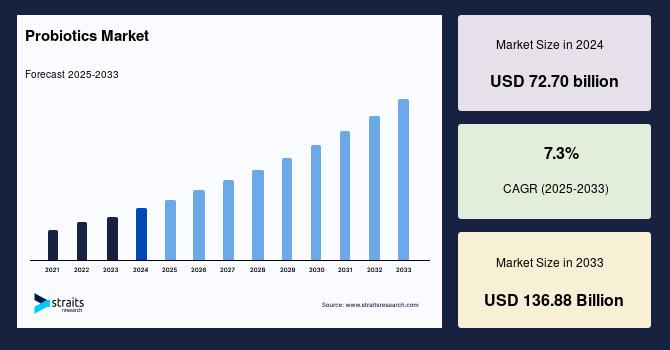The Global Probiotics Market: Transforming Health and Wellness by 2033

The global probiotics market size was valued at USD 72.70 billion in 2024, and It is expected to reach from USD 77.90 billion by 2025 to USD 136.88 billion by 2033, growing at a CAGR of 7.3% during the forecast period (2025–2033).
Understanding Probiotics and Their Health Benefits
Probiotics are live microorganisms, including beneficial bacteria and yeast, that support the intestinal flora and contribute to maintaining a balanced digestive system. They stimulate natural digestive enzymes and juices, which help in nutrient absorption and protect the body against harmful pathogens. Beyond digestive benefits, probiotics are now recognized for their role in treating neurological conditions, mental health issues, and reducing oxidative damage to proteins and lipids.
The health benefits of probiotics extend into boosting the immune system, preventing bacterial infections, and supporting overall wellness. This has made probiotics an essential component in dietary supplements as well as in everyday foods and beverages. The shift towards preventive healthcare and natural remedies continues to fuel consumer interest and uptake of probiotic products.
Rising Demand in Human and Animal Health
The demand for probiotics spans both human health supplements and animal nutrition sectors. In human health, probiotics help address a range of health concerns such as digestive disorders, obesity, lactose intolerance, and immune deficiencies. The rapidly aging global population and increased focus on wellness and disease prevention are major drivers for probiotic supplement consumption.
In the animal feed industry, probiotics are increasingly used as alternatives to antibiotics for promoting growth, disease resistance, and gut health in livestock and aquaculture. Regulatory restrictions on antibiotic use, especially in regions like the European Union, have accelerated the adoption of probiotic additives to maintain animal health and productivity. This trend supports sustainable farming practices and responds to rising consumer demand for antibiotic-free meat products.
Regional Market Insights
Asia-Pacific holds the largest share in the global probiotics market, fueled by growing health consciousness, rising disposable incomes, and expanding urban populations. Countries such as China, India, Japan, and South Korea are leading consumers, thanks to increasing acceptance of functional foods and dietary supplements. The region’s growing middle class and improved standards of living further bolster demand for probiotic products.
Europe is the fastest-growing region, with a CAGR near 7%. Regulatory developments, such as clearer labeling standards for probiotic products in countries like Denmark, the Netherlands, and Poland, have increased consumer confidence and market penetration. The rise of lifestyle diseases such as obesity and diabetes also drives demand for functional foods and supplements rich in probiotics.
North America remains a mature and significant market due to advanced healthcare infrastructure and high consumer awareness. Increasing demand for dairy-free probiotic options and functional foods further stimulates growth. In Latin America, rising health awareness combined with digitization and expanding e-commerce channels create new opportunities for probiotic sales.
The Middle East and Africa are emerging markets with increasing interest in health and fitness. Probiotic usage is expanding here due to dietary habits, growing agricultural practices incorporating probiotics in animal feed, and government initiatives against lifestyle-related diseases.
Product Types and Trends
Probiotic food and beverage products constitute the largest segment within the market, accounting for substantial revenue shares and strong future growth. These products offer consumers convenient and enjoyable ways to enhance their gut health without taking pills or capsules. Dairy-based products have traditionally dominated this category, but demand is growing rapidly for non-dairy probiotics to cater to lactose-intolerant and vegan consumers.
Dietary supplements such as capsules, tablets, and sachets remain highly popular, especially among aging populations and individuals seeking targeted health benefits. Manufacturers are increasingly investing in the development of novel probiotic strains to address specific health needs like immune support and metabolic health.
The bacteria segment dominates the probiotic microorganisms category, with genera such as Lactobacillus and Bifidobacterium widely used for promoting gut health. Probiotic yeasts, particularly Saccharomyces boulardii, are gaining importance due to their distinct probiotic properties and effectiveness in treating gastrointestinal disorders.
Challenges and Opportunities
Despite the significant growth, the probiotics market faces challenges related to product awareness, especially in rural and non-metropolitan areas in developing countries. Limited knowledge among healthcare professionals and constrained product availability can restrict market expansion in these regions.
Moreover, rigorous regulatory environments in various countries require manufacturers to demonstrate clear health benefits and ensure product safety and efficacy. Investment in research and development to discover new probiotic strains and to improve product formulations is crucial for sustaining market momentum.
On the opportunity front, increasing consumer interest in natural health solutions presents numerous avenues for innovation. Functional foods enriched with probiotics, personalized probiotic supplements, and expanding probiotic use in animal health constitute dynamic areas of growth.
Future Outlook
The global probiotics market is poised for continued expansion driven by a growing global population concerned about health, increasing prevalence of digestive and lifestyle disorders, and rising preference for preventive healthcare. Advances in microbiome research and biotechnology will enable new probiotic applications and enhanced efficacy, further boosting consumer confidence.
- Art
- Causes
- Crafts
- Dance
- Drinks
- Film
- Fitness
- Food
- Games
- Gardening
- Health
- Home
- Literature
- Music
- Networking
- Other
- Party
- Religion
- Shopping
- Sports
- Theater
- Wellness


